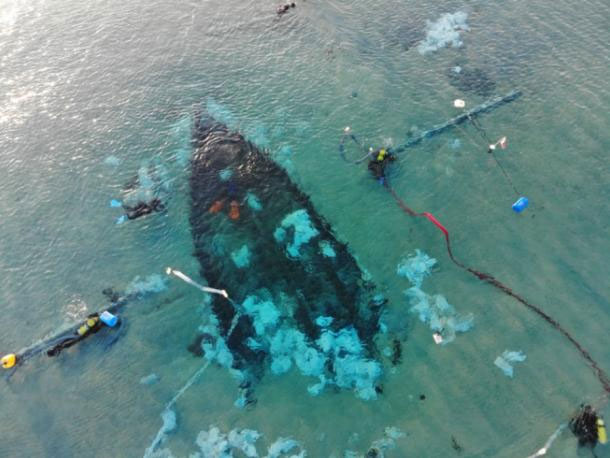A research team led by the University of Haifa (Israel) has excavated and studied an ancient shipwreck. “An unusual source of information,” as described by Ancient Origins, consists of tiny skeletons that are as eerily intact as the ship itself.
According to a publication on the website of the Leon Recanati Institute for Maritime Studies, Ma’agan Mikhael B is a 25-meter-long merchant ship that sank at a depth of only 3 meters, located 70 meters off the coast of Israel. The ship had not been seen for centuries, likely buried under sand.

The ancient shipwreck being salvaged – (Photo: UNIVERSITY OF HAIFA)
The ancient shipwreck appears astonishingly well-preserved, from the main structural frames to the bulkheads and mast steps, as if it had just sunk a few days ago. The entire hull, along with cargo and the daily belongings of the crew, remains intact.
According to a report recently published in the Journal of the Council for British Research in the Levant, this is the largest Byzantine maritime archaeological discovery along the coast of Israel to date. The ancient Islamic pottery found on board is particularly valuable historically, including numerous amphorae—an ancient type of jug with two handles, a bulbous body, and a narrow neck.
Inside the ceramic jars—most of which have lids—were well-preserved goods, including Turkish walnuts and a traditional fish sauce from the Sea of Galilee. Repair tools, wooden artifacts, glass items, coins, and even skeletal remains were also found on the ship.
However, the most intriguing discovery was the tiny skeletons: mouse bones, likely from mice that carried the “Black Death” due to the fleas they harbored.

The ship and its unusually intact cargo, possibly due to the marine environment in the Mediterranean and being buried in sand – (Photo: UNIVERSITY OF HAIFA)
According to Business Insider, it is unclear whether these mice carried disease, but they are tangible evidence of how rats traveled on merchant ships and spread across regions in the 1400s. This was a horrific period of the plague that swept across many parts of the world, especially Europe, where it is estimated that two-thirds of the population was wiped out.
Bone analysis revealed that these were black rats, known to have arrived in the Middle East on merchant ships from South Asia over 2,000 years ago; however, their dental morphology shows unusual hybrid characteristics. They may have lived in Tunisia or Corsica before boarding the ship.


















































